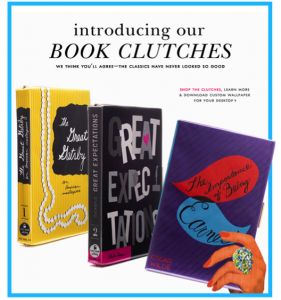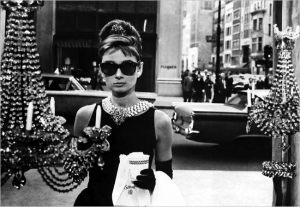Recently, it seems as if brands are beginning to embrace the bookish, nerdy side in all of us. I was especially struck by Kate Spade’s collection of clutches that looked like books. They started off with The Great Gatsby, Emma, Pride and Prejudice, The Importance of Being Earnest, Great Expectations, and Romeo and Juliet. The series apparently became so popular that Kate Spade decided to roll out more—now, one can purchase The Age of Innocence, The Portrait of a Lady, and A Tale of Two Cities. All clutches feature brightly colored and dynamically designed “covers,” which bear no resemblance to any prior publisher copies. For $328 you too can show off how well read and stylish you are, or you can be stylish and pretend you’re well read. 
So what is it that makes this high-end retailer decide to begin marketing icons of literature in such a way? Why were these titles picked? Is what Kate Spade puts on their clutches suddenly going to be what every fashionable cosmopolitan 20-something decides they have to read? Is literature fashionable? I certainly can’t answer all these questions, but I’ll take a stab at it.
I think perhaps the big on-screen adaptations of classic novels could have, in part, inspired these items. Great Gatsby? When people heard it was being remade, pretty much the whole country ran out to re-read the book, and then go on to misinterpret the point of the novel as “wow Gatsby threw great parties, huh?” and decide that 20’s fashion is in. Classics like Anna Karenina and Jane Eyre were also recently made into movies, both encouraging people to reread these popular novels but also showcasing gorgeous costumes. As for the titles picked, they clearly skew very classic, popular novels accepted as canon, and nothing that would be too controversial. This ensures that people know the books and that people would want to purchase the clutches because they know an enduring novel means an enduring fashion statement.
Will these books have a sudden reemergence in the set of modern young women who would purchase such items? Possibly. Just like movie adaptations reinvigorate book sales, so could fashion. But these are also novels that constantly get reread and rediscovered. Dickens, Austen, Wilde, and Shakespeare are read constantly, though of course some socialite who doesn’t often read could pick up one of these clutches and think, “Hmm, The Importance of Being Earnest sounds good, maybe I should read it.”
Interestingly, the relationship between fashion and literature is symbiotic. After clicking about on the Internet, I learned that books and literature can inspire fashion designers as well. A Japanese clothing brand, Juliette et Justine, was inspired by the Marquis de Sade’s books—expect some lace, ruffles, and chokers. Prabal Gurung’s Fall 2011 line was inspired by Miss Havisham in Great Expectations. Desiging Duo Shipley and Halmos’s Fall 2009 collection was inspired by “the philosophy of Ayn Rand (http://flavorwire.com/162418/books-that-inspired-fashion-designers/). These examples would make any literary snob skeptical, I’m sure. The Marquis de Sade? Wouldn’t have gone anywhere near fluffy and cutesy clothing. Miss Havisham? Only wears her old wedding dress; that could barely serve as inspiration for a whole line. Ayn Rand? I would hazard a guess that she almost has more critics than admirers now and who even knows how to translate that into clothing. But I think what we can glean from this is that people will always interpret literature the way they want to. And that’s not necessarily a bad thing—literature serves to inspire, even if the clothing line isn’t the same wedding dress done 12 different times.
 Literary characters are often described and even defined by their outfits. Clarissa Dalloway wears her “silver-green mermaid’s dress” at her party, Anna Karenina wears “a low-cut black velvet gown,” and Hester Prynne wears the scarlet letter—not her own choice of a fashion statement, but still. Perhaps the most iconic combination of fashion in literature is Holly Golightly, of Capote’s Breakfast at Tiffany’s—the everyday woman might not be able to tell you what happened in the novella but they will know that Audrey Hepburn wore a slim black dress, pearls, and big black sunglasses.
Literary characters are often described and even defined by their outfits. Clarissa Dalloway wears her “silver-green mermaid’s dress” at her party, Anna Karenina wears “a low-cut black velvet gown,” and Hester Prynne wears the scarlet letter—not her own choice of a fashion statement, but still. Perhaps the most iconic combination of fashion in literature is Holly Golightly, of Capote’s Breakfast at Tiffany’s—the everyday woman might not be able to tell you what happened in the novella but they will know that Audrey Hepburn wore a slim black dress, pearls, and big black sunglasses.
Literature CAN be incorporated into fashion, and fashion often occurs as a statement in literature. The relationship might not be the most overt, but the symbiosis is there. Do you agree? Would you pay $328 for a Pride and Prejudice clutch? Is there a literary figure that you think wore something pretty iconic? I’d love to hear it! –Taylor McPherson
